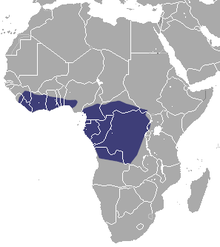Small frilled bat
| Small frilled bat | ||||||||||||
|---|---|---|---|---|---|---|---|---|---|---|---|---|

Museum copy |
||||||||||||
| Systematics | ||||||||||||
|
||||||||||||
| Scientific name | ||||||||||||
| Myonycteris torquata | ||||||||||||
| ( Dobson , 1878) |
The small-frilled bat ( Myonycteris torquata ) is a fruit bat in the genus group of rosette bats .
features
Regardless of the German common name, the species has a head-to-trunk length of 88 to 120 mm, a forearm length of 56 to 67 mm and a weight of 27 to 60 g, about the same size as other members of the genus. It reaches a wingspan of 280 to 305 mm and has 13 to 21 mm long ears. The tail may be missing or it may be a stub up to 13 mm long. Red-brown to yellow-brown fur occurs on the top of the body, while the underside is covered by lighter brown, gray-brown, or light gray fur. Furthermore, the head, neck and shoulders are lighter in color due to colorless or light brown sections of hair near the hair root . Males have a ruff made of bristle hair, which is not contrasted in color from the head. At epaulets missing reminiscent white patches on the shoulders. Before sexual maturity, young animals are generally darker. Regardless of age, there is a woolly spot on the throat of all specimens. This woolly hair also covers the chin and chest of adult males. At different times of the year, the oily secretion from a gland on the throat turns the area orange-yellow.
The small frilled bat has dark brown, slightly pointed ears, dark brown wings and a tail flight skin that is partially covered with fur. The toes are minimally connected with skins. In the transverse bulges on the palate , the front three are completely interrupted and the rear two are interrupted in the middle.
distribution
This flying fox lives in central Africa. It reaches Cameroon , the Central African Republic and possibly South Sudan in the north . The western border of the distribution area extends from Uganda via Rwanda to the south of the Democratic Republic of the Congo . The southern border is in northern Angola . One population lives on Bioko ( Equatorial Guinea ).
Populations in West Africa, which were previously listed as the subspecies Myonycteris torquata leptodon , represent a separate species according to a taxonomic study from 2013.
The small-frilled bat mostly lives in tropical rainforests . He continues to visit landscapes that are formed as a mosaic of forests and grassy areas (mostly in the rainy season ) and gardens in cities.
Way of life
Individual specimens or smaller groups can be found at the resting place. Males exhibited a migratory behavior shortly after sexual maturity. During sleep, the animals cling to the branches of trees or bushes, occasionally in direct sunlight.
Presumably the food consists mainly of soft fruits, some of which are brought from distant places. In the feces of some individuals, seeds of plants of the genus nightshade ( Solanum ) could be detected, which grew only several kilometers away. Specimens kept in captivity ate fruits of the genera fig , banana , adenia , musanga and nightshade. May include nectar and pollen for food.
In Gabon, the offspring were born in December and January. One young is born per litter.
threat
Regionally, intensive use of forests or the conversion of forests to arable land can have a negative impact on the local population. The total population is estimated to be stable. The IUCN lists the small frilled ugly hound as Least Concern . Due to the division into two types, a reassessment may be necessary in the near future.
Individual evidence
- ↑ Don E. Wilson , DeeAnn M. Reeder (Ed.): Mammal Species of the World . A taxonomic and geographic Reference . 3. Edition. 2 volumes. Johns Hopkins University Press, Baltimore MD 2005, ISBN 0-8018-8221-4 (English, Myonycteris torquata ).
- ↑ a b c d e Jonathan Kingdon (Ed.): Mammals of Africa . IV, Hedgehogs, Shrews and Bats. A&C Black, 2014, p. 275-276 ( Little Collared Fruit Bat ).
- ↑ a b c d e Myonycteris torquata in the endangered Red List species the IUCN 2016 Posted by: Bakwo Fils, EM & Kaleme, P., 2014. Accessed July 26, 2020th
